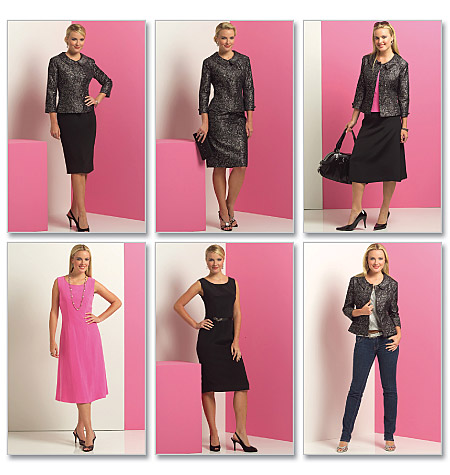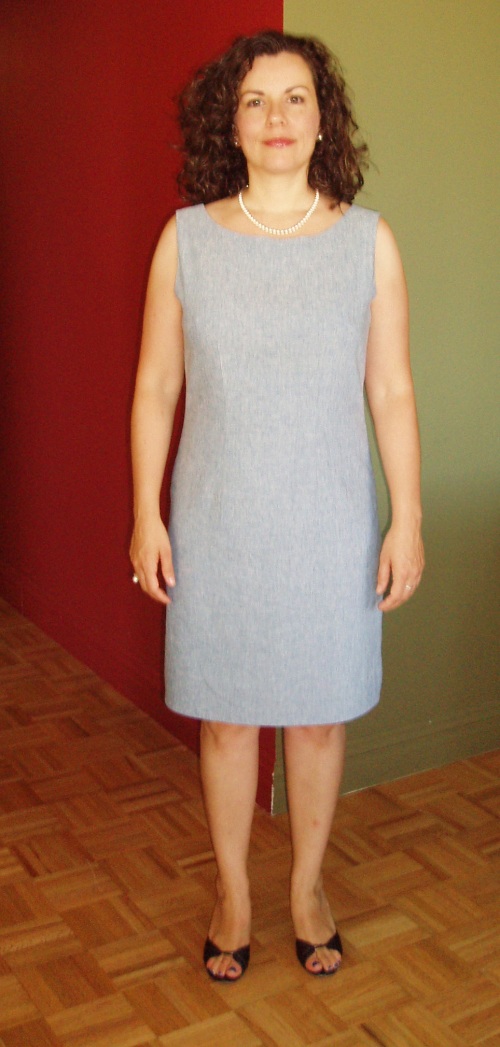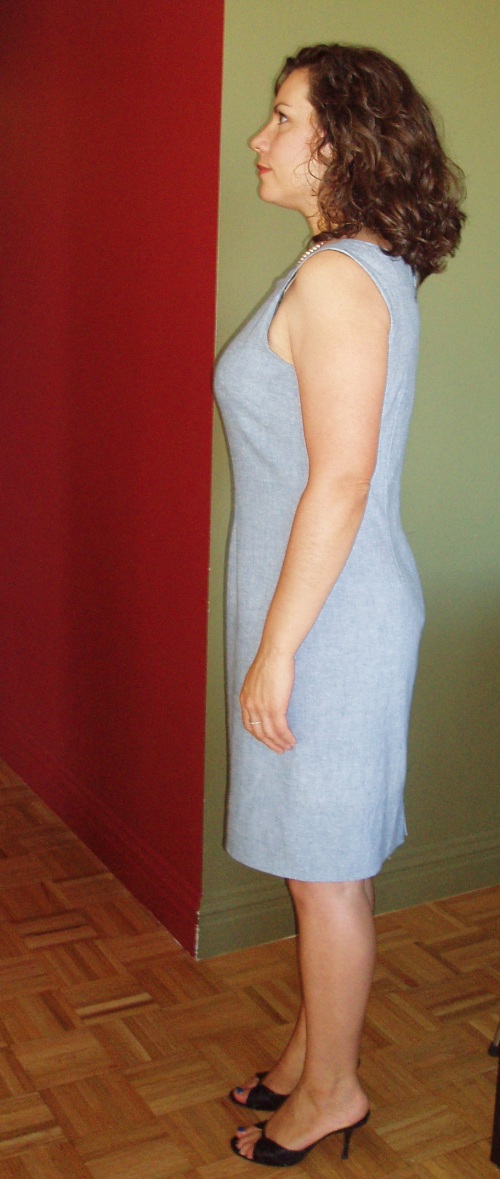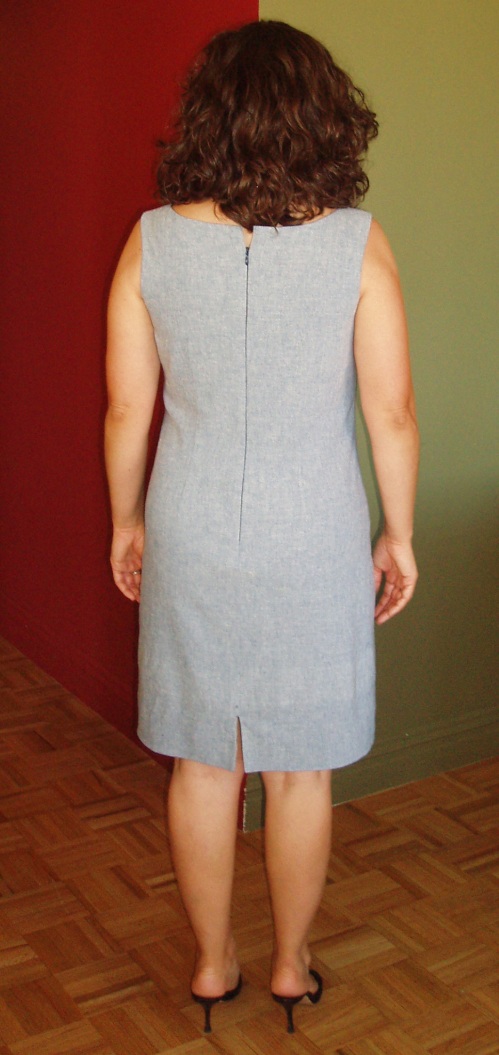
Butterick 5147
Pattern Description: Lifestyle Wardrobe: Misses Jacket, Top, Dress, and Skirt. Slim fitting dress C has front and back darts, back zipper and back slit, length is 2 inches below mid-knee.
Pattern Sizing: BB (8-14) I made the size 14 with some small alterations (see below)
Did it look like the photo/drawing on the pattern envelope once you were done sewing with it? Yes, but not as close fitting.
Were the instructions easy to follow?
- Yes for the most part. I liked the order of construction they set out as it provides a beautiful clean finish on the inside. However they do not tell you to stay stitch the neck and my neckline stretched out. I should have listened to my inner sewing voice and put in stay stitching.
- For the fish eye darts, I recommend starting the stitching line in the middle of the dart rather than at one of the two ends (thanks to my commenters for this tip!). This allows for more accurate sewing at both ends of the dart for a beautiful taper resulting in no bubble at the tips. Don’t forget to make your stitch length smaller at the ends of the darts!
- The instructions for finishing the slit with the lining and dress hem joined together are great! I didn’t understand them at first by just reading them, but if you follow them step by step, you’ll understand. I am visual person, so reading wordy stuff doesn’t always make directions apparent for me. My one caveat about the slit instructions is that you should finish the raw edge of the hem long before you get to this step, like before you start constructing the dress with zigzag stitching or by serging. Ask me how I know!
- One more note: Understitching the lining of the slit is really hard to do on the machine. It’s doable but difficult to maneuver all the fabric into just the right position. It’s far less of a headache to just understitch it by hand and quick too.
What did you particularly like or dislike about the pattern?
Likes:
- I liked that the pattern was pretty true to size according to the measurements given on the pattern envelope. After the 6 inch debacle, it was such a treat not to have a nasty surprise when making the muslin on this dress.
- Love this sheath dress. I think it’s very flattering (much more so in real life than in the following pictures) and is such a great staple to have in the work wardrobe. Depending on the fabric you use, this dress can be a statement piece or an elegant foil for some great accessories. I think everyone looks well dressed in a well-fitting sheath dress.
- I love this neckline. It’s not too high, not too low. I hate necklines that are high and rest on my clavicles (I feel like I’m being strangled!), so this neckline is just right for me and Goldilocks.
Dislikes:
Fabric Used: I just bought this fabric from Paron’s last weekend. I am so proud of myself for using it within a week of buying it. It’s a stretch chambray. Not to get all philosophical on you, but I liked the juxtaposition of using a traditional work horse fabric for an elegant sheath dress. I wore it with pearls today and I think by accessorizing the dress like it was made with silk really elevates the fabric from it’s humble origins. I love chambray; it’s so soft and comfy. I do have to mention, however, that I am not a fan of stretch wovens so far. They are a little tricky to work with as they grow as you handle them. I had to take in the side seams to accommodate the growth during construction, despite having made two muslins beforehand. Also, the feel of the fabric doesn’t feel as natural as a plain cotton would, a little rubbery.
Pattern alterations or any design changes you made: During the muslin stage, I had Thea help me with fitting, as I mentioned in my last post, the changes we ended up making were not even close to the ones I thought I would make. I thought all I needed was a swayback adjustment, but we took out an inch from the shoulders of the back pattern piece. The strange thing about this was that it didn’t significantly change the shape of the armscye AND I didn’t need to add that inch back in at the back hem. Go figure! Then added a ¼ inch at the side seams to add a full inch of ease to the dress. Also, my left hip is not as curvy as my right, so I straightened that curve and took it in another ¼ inch to fit my hip better. As I mentioned above, my stretch fabric grew with handling so after I basted in the side seams, I had to take in both side seams another ¼ inch again to accommodate the fabric. The only further changes I might consider making is making it a little more fitted like it seems to be on the pattern envelope. But I will decide this after wearing it for a full day. It’s comfortable as is now, but maybe a little more fitted might be even more flattering? Who knows. It could just end up emphasizing the pooch and who wants that? Not me! I wish I worked with people who sewed, so I could ask their opinion. *sigh*
Would you sew it again? Would you recommend it to others? This dress was made as part of the Butterick 5147 Dress Sew Along that Carolyn and I started (still going on for another few weeks – please join!) It was on my list to try as a potential TNT (tried n true) pattern for my work wardrobe. Since I consider it a success, I will definitely be sewing it again and again. There are only two pattern pieces and four darts. Can it get any simpler than that? I definitely recommend it to others. I think it will flatter most figures after adjusting for each individual’s fit. And the directions are great (aside from leaving out a couple of important steps mentioned above). I definitely think a beginner could handle this pattern if they have a good sewing reference sitting beside them.
Conclusion: This dress has become my second TNT in my TNT quest for a work wardrobe. I love the fit, the elegant silhouette, and the fact that the fabric is the star of this pattern. You will not look like you are making the same dress over and over if you use vastly different fabrics. I plan to make this again right away using my new silk twill border print (also bought at Paron’s during the same visit last week). Can’t wait!!!!! Also I absolutely adore the jacket included in this pattern. I hope to make that sometime in the near future. I have a lot on my plate now, but that jacket is definitely on my horizon.
Now for some pictures… Thanks to my sister taking them this morning even though she was rushing to get out the door! This is how I wore my dress at work today. I don’t have any construction pictures as I didn’t do anything too different or awe inspiring to document them. Besides, this dress is all about getting the right fit, not how you hand sew the hem. 😉



I’m going back to remedial sewing school with Thea this weekend and cutting out my precious silk twill under her wise tutelage. I had some grain issues with my first iteration of this dress and I don’t want to chance ruining my silk twill dress. Hopefully, by this time next week, I will have another new Butterick 5147 dress to show you all!
Happy sewing everyone!






















